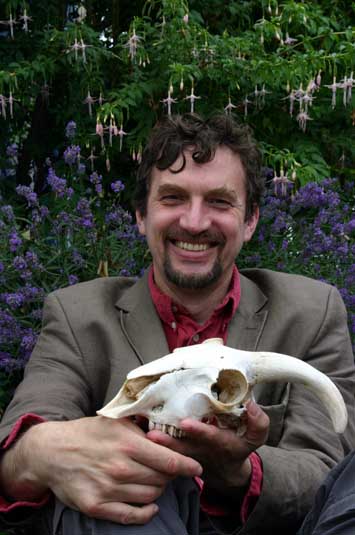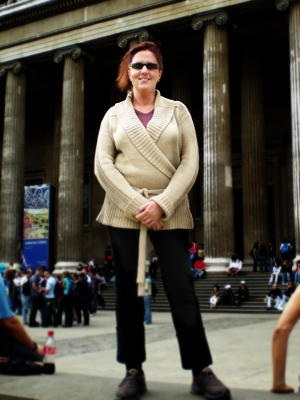Live Interpretation Manager of Historic Royal Palaces and King Arthur Expert Christopher Gidlow is the Live Interpretation Manager of Historic Royal Palaces. He specialises in bringing history to life at the Tower of London, Hampton Court Palace, Kensington Palace and the Banqueting House Whitehall. He is also responsible for interpretation on the project to open the Georgian Kitchens of Kew Palace to the public. He is also a director of the International Museum Theatre Alliance (Europe). A life-long enthusiast for the Arthurian legends, Christopher describes being told by his primary teacher that they might have a basis in fact as…
-
-
The book of human history will need a slight redraft, if a remarkable claim by a prominent Georgian anthropologist and archaeologist – on the basis of human remains recently excavated at a site not far from the Georgian capital Tbilisi – is true. The skulls, jawbones and fragments of limb bones dug up between 1991 and 2007 near the medieval village of Dmanisi in the foothills of the Caucuses are, according to Professor David Lordkipanidze – Director General of the Georgian National Museum – indisputably the oldest human fossils found outside of Africa, at around 1.8 millions years of age.…
-
Egyptologist 11 November 1942 Dr Rolf Krauss is a renowned German Egyptologist who – prior to retiring in 2007 – last worked as a researcher at the Berlin Museum of Prehistory and Early History, and as a lecturer at Humboldt University. He has produced a number of important studies into ancient Egyptian chronology and astronomy. Born in Heidelberg in 1942, Dr Krauss studied at the University of Heidelberg and the Free University of Berlin from 1975 to 1981, gaining his PhD in Egyptology from the latter institution. He went on to work at the Egyptian Museum in the National Museums…
-
The New Acropolis Museum is arguably the most high-profile building to go up this decade (since we in New York are still peering into a big hole in the ground that is supposed to produce a new World Trade Centre). Essentially a smack in the face of the British Museum’s argument that Athens has no suitable venue in which to house the Elgin Marbles, it’s also the most controversial. I spoke to Bernard Tschumi, the outspoken architect who designed this extraordinary building. Replacing the smaller old Acropolis Museum, the purpose-built new museum ensures that architectural treasures too delicate to be…
-
Geoff Holder Author and forteana expert Geoff Holder is the author of more than a dozen books on everything mysterious, paranormal, strange, gothic and grotesque. His books are an authoritative mix of extensive historical study combined with diligent field research. They are often geographically-based, with titles such as The Guide to Mysterious Glasgow and The Guide to the Mysterious Lake District. Holder is primarily interested in ‘forteana’ – the world of the odd, the curious, the wondrous, the allegedly paranormal – and its fractious and informing relationship with the so-called mundane world. What do people do when they have too…
-
Architecture in Roman Britain by Guy de la Bédoyère The Roman period was Britain’s first great architectural age, though this is difficult to appreciate from the ruinous state of the sites that survive. Understanding the types and range of buildings that existed in Roman Britain depends on careful excavation of foundations and wall footings, together with fragments of windows, roofs and carved architectural decoration discovered among the debris. When this evidence is taken together with examples of better-preserved buildings that still exist in Europe, the Near East and North Africa, it is possible to recreate something of the architecture of…
-
Paula Veiga Researcher in Egyptology 13 April 1968 Paula Veiga has a background in tourism, but holds a Master in Pre Classical Studies from the University of Lisboa and a Master in Biomedical Egyptology from the Faculty of Life Sciences, University of Manchester (which covers Histology studies and laboratory practice, DNA studies and practice of extraction, Paleopathology, Osteology, amongst other disciplines). She recently published her first book – Oncology and Infectious Diseases in ancient Egypt: The Ebers Papyrus? Treatise on Tumours 857-877 and the cases found in ancient Egyptian human material and has another one upcoming. Paula Veiga is working on…
-
What lies behind the legends of King Arthur? Fragments of history, or just wishful thinking? While historians study the ancient manuscripts, modern archaeologists join in the hunt for clues. From Arthur’s ‘birthplace’ at Tintagel to the fabled ‘Isle of Avalon’, we sift through the evidence. Journeying across Arthur’s Britain, we search for Camelot and the sites of his battles. Do the remains confirm or contradict the traditional accounts? Far from providing objective proof, Christopher Gidlow shows how archaeologists’ interpretation of their discoveries reflects the academic fashions of their times. Sites which in the 1960s were used to prove King Arthur’s…
-
Professor of Egyptology at the American University in Cairo Dr Salima Ikram – one of the world’s leading authorities on Egyptian religion – recently chatted to Heritage Key on the subject of the cult of animal worship in ancient Egypt. In another exclusive new video interview, she dons her white coat and takes us to the lab, for a fascinating insight into the practice of animal mummification. Animals were deeply sacred in ancient Egypt, particularly from the 26th dynasty – around 700 BC – until the end of Egyptian civilization and the advent of Christianity by 400 AD. They were…
-
Archaeologists have made two major tomb discoveries at the ancient city of Petra in southern Jordan. They discovered a rock-cut tomb that contained the skeletal remains of 61 individuals, along with a wealth of wooden artefacts, animal bones and ceramics. The second discovery was made at a place called tomb 676. While excavating it archaeologists found a gold medallion with an Islamic inscription on it. The find dates to long after the tomb was abandoned. “This object was placed in the tomb in a later period – perhaps as a way of warding off evil coming from the tomb,” said Professor David Johnson, of Brigham Young University in Utah, who led the team that made both tomb…



